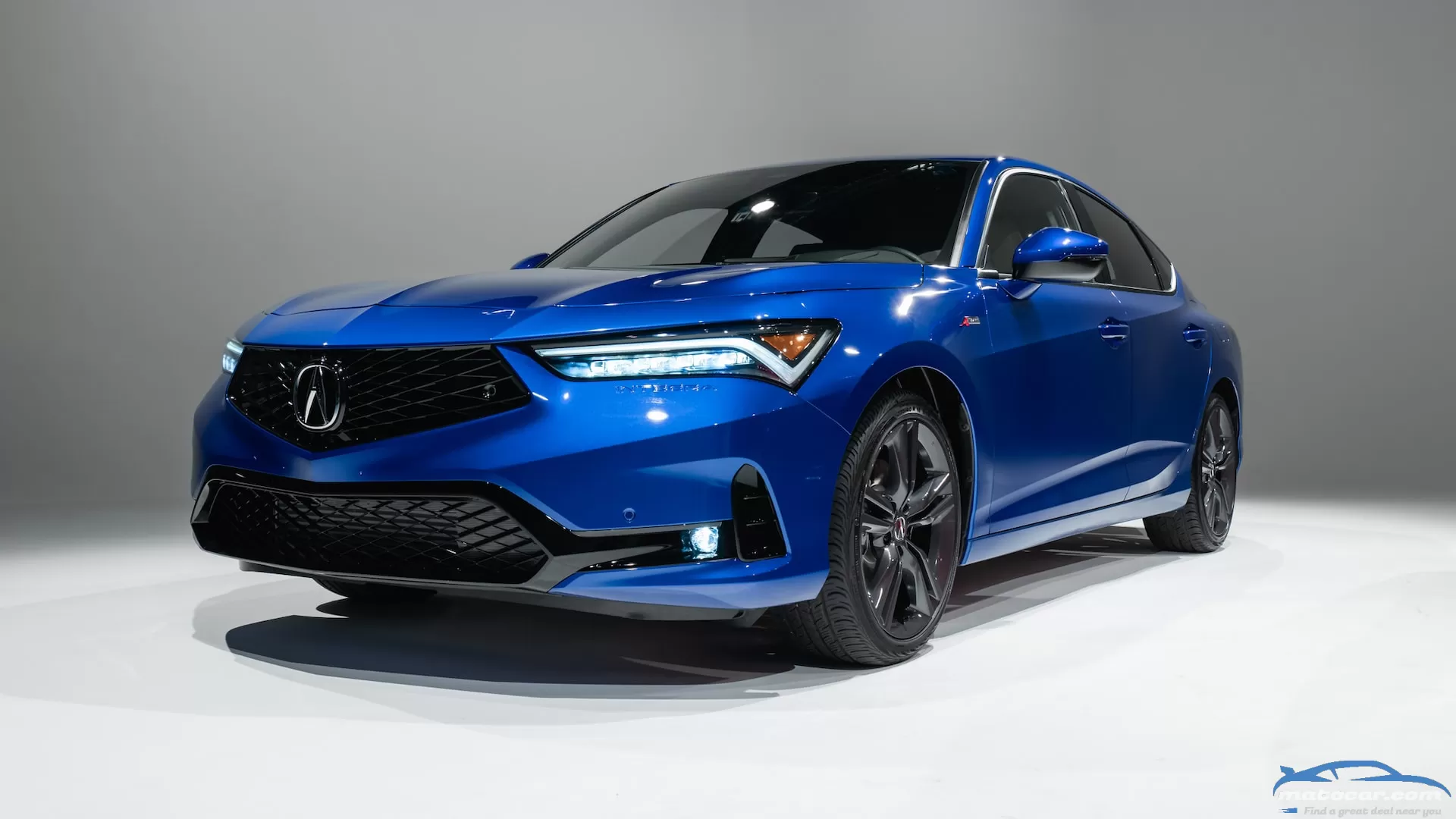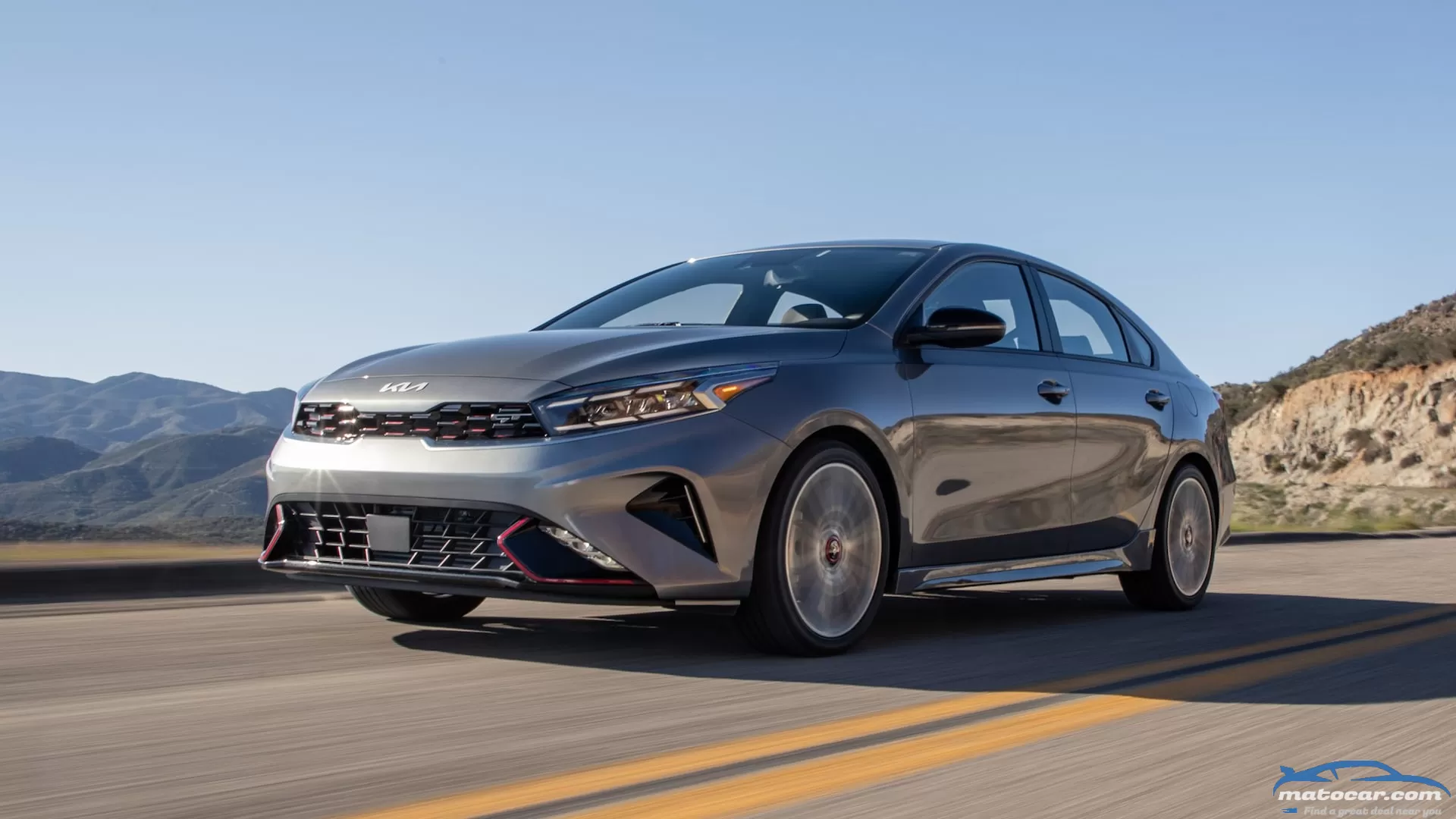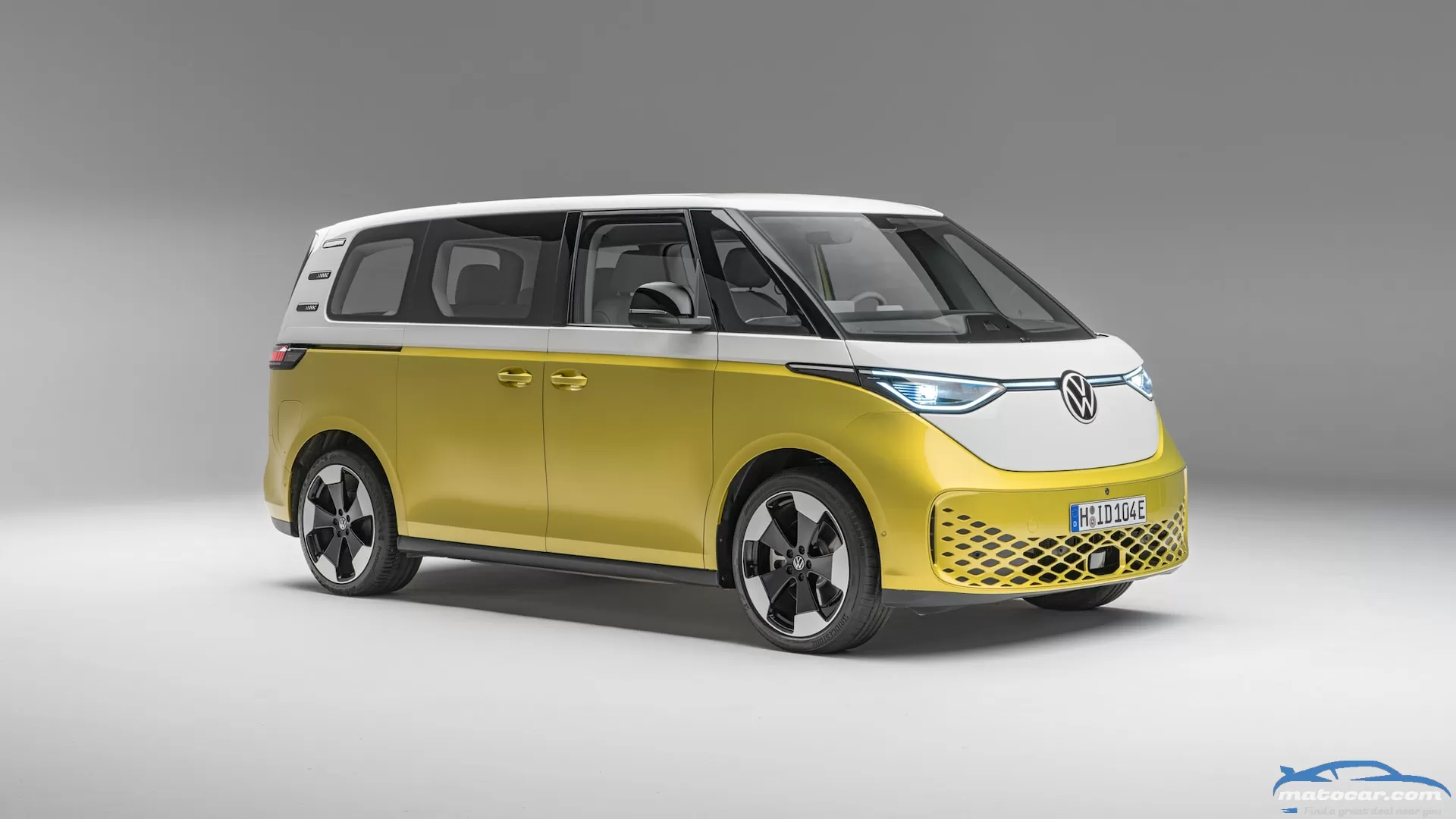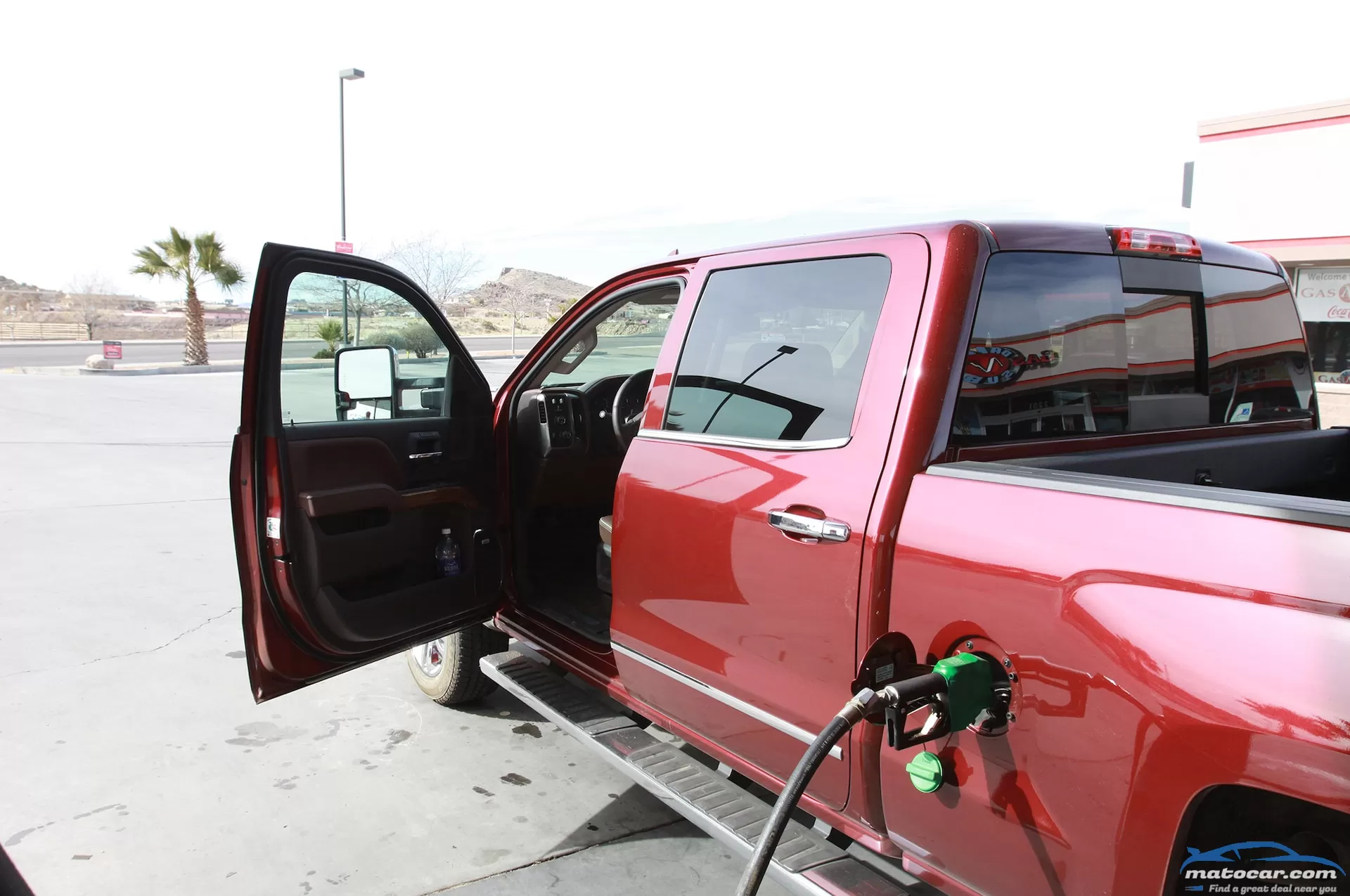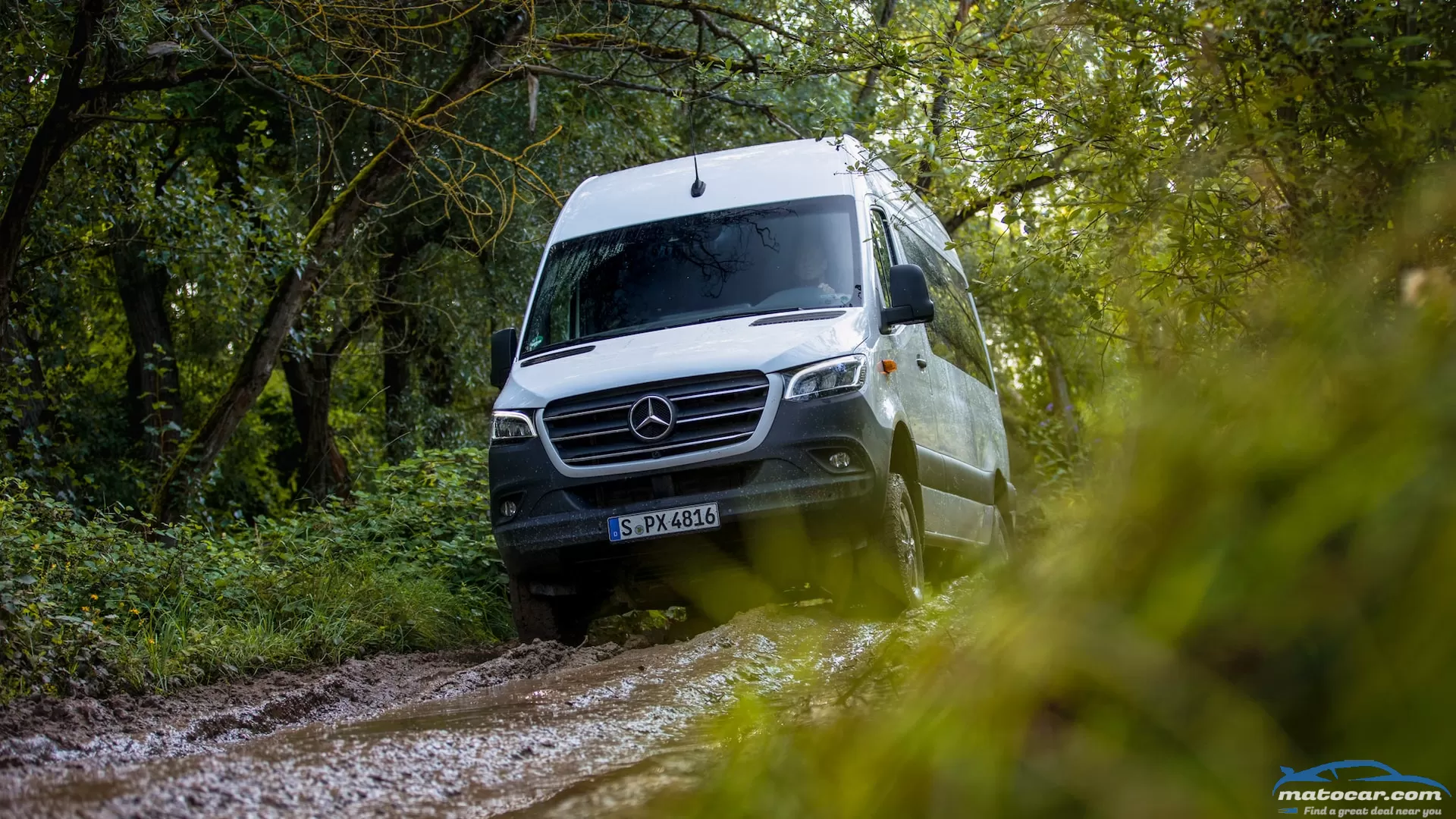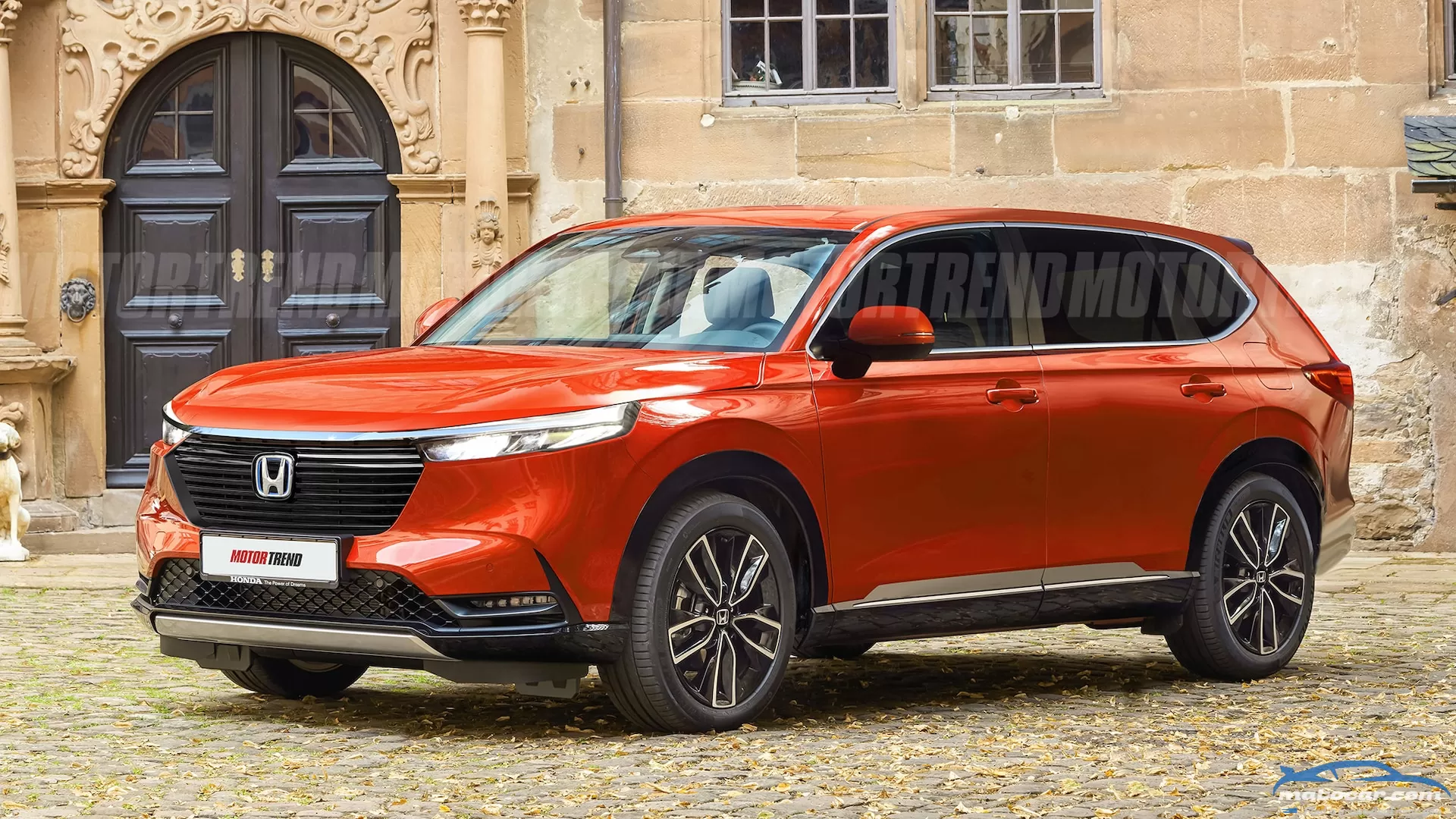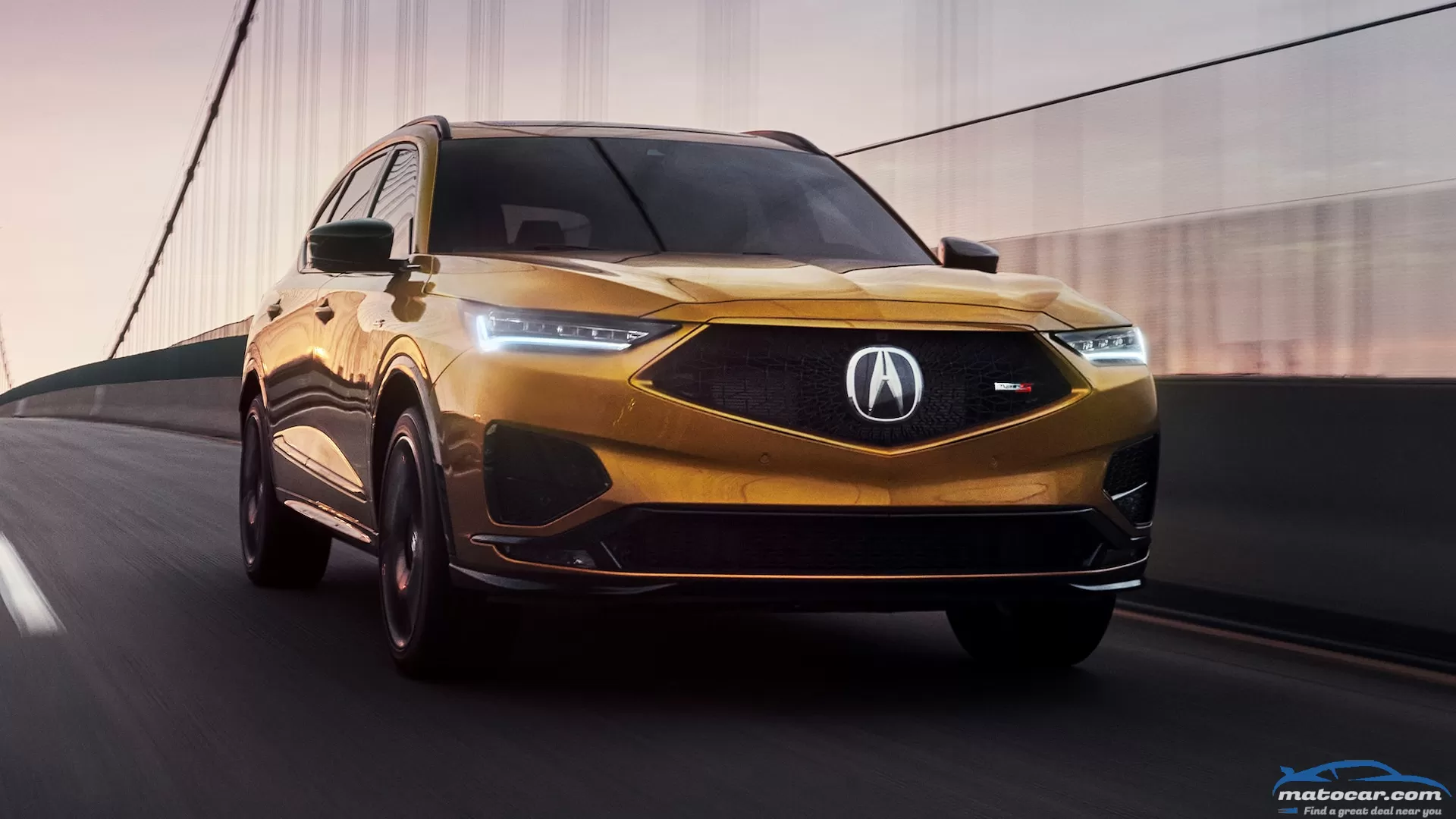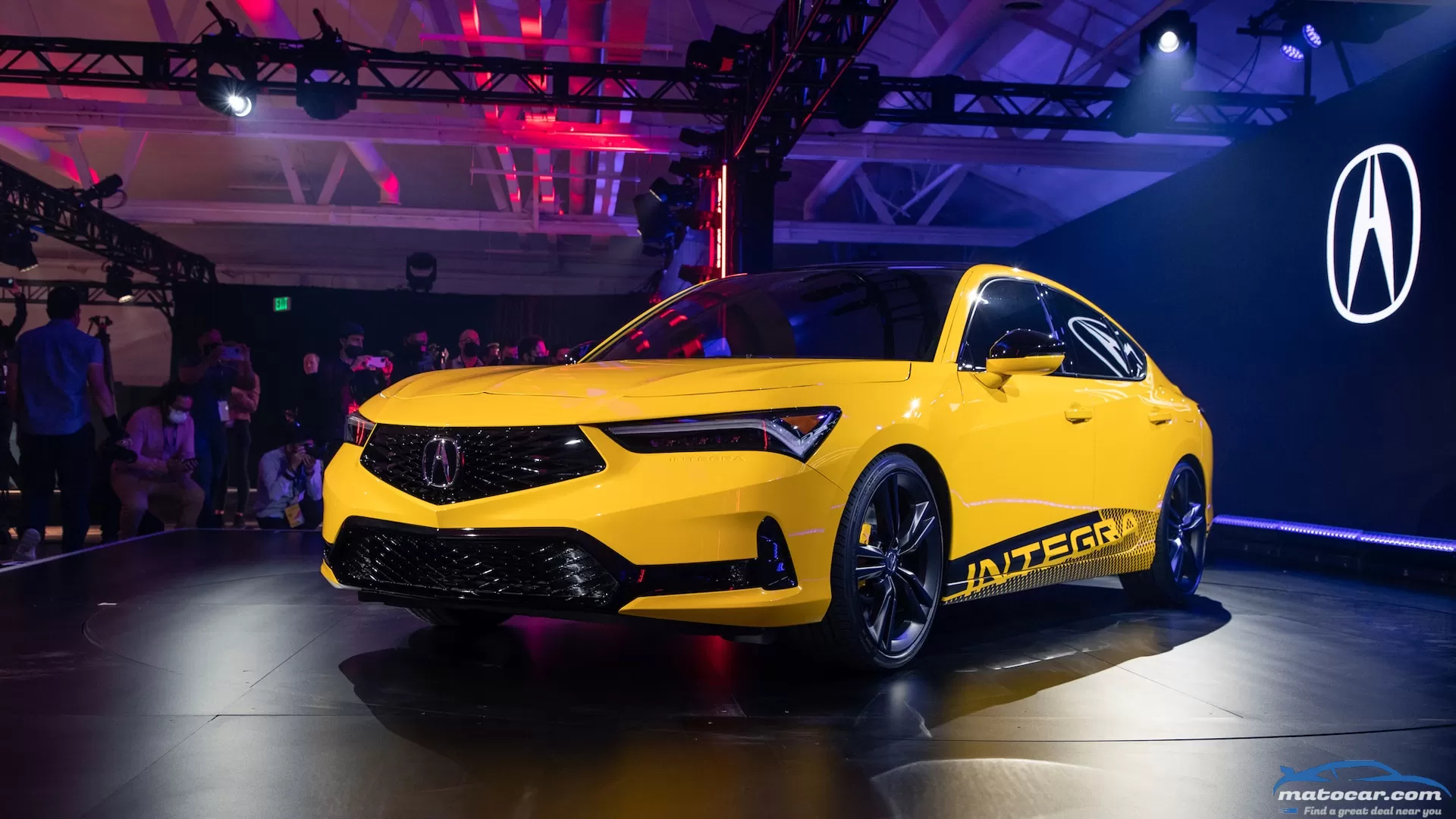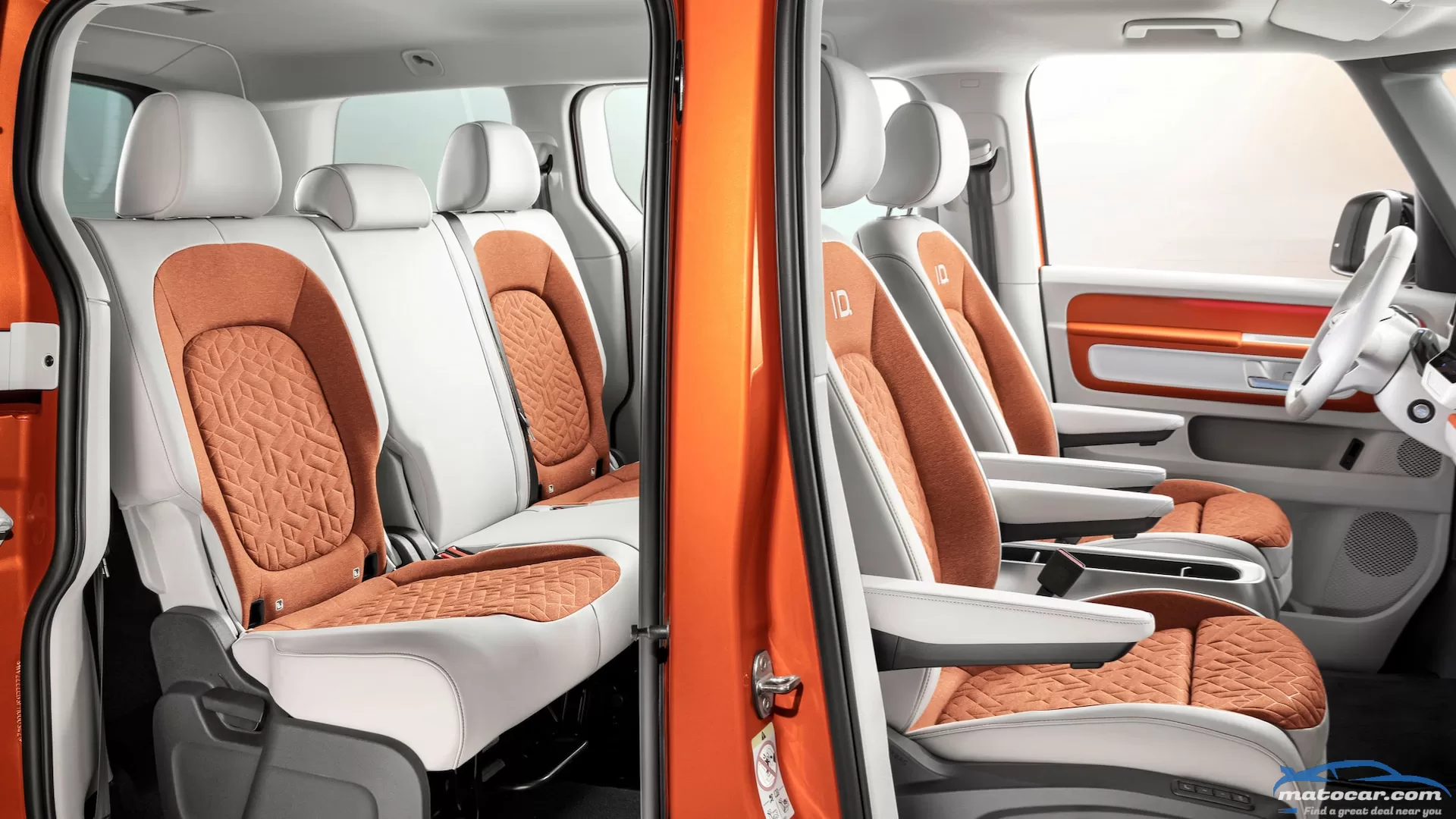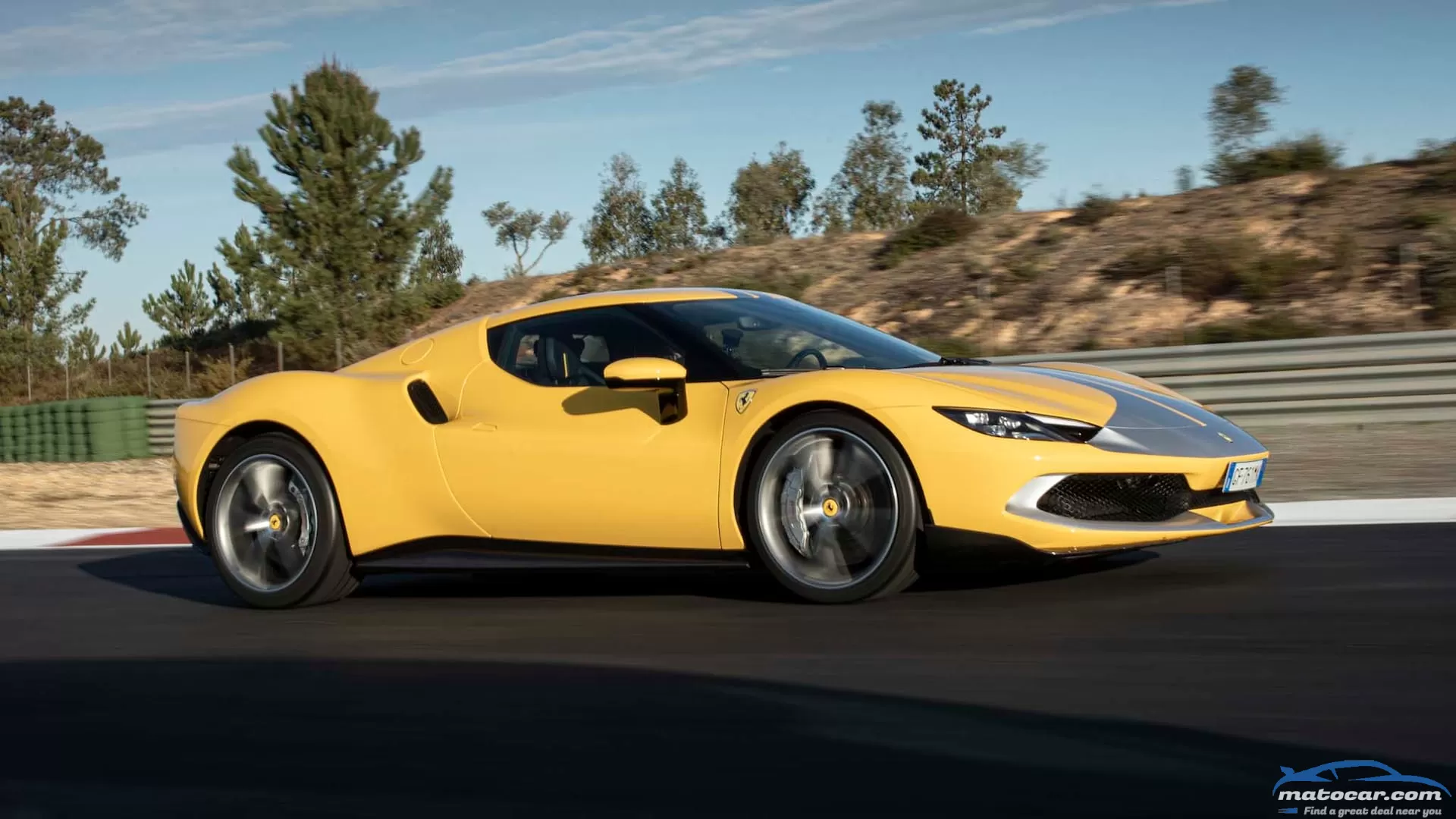When Acura showed the Integra Prototype in November of last year, the reaction was overwhelming. Some applauded the iconic sport compact's return, while others gave its style thumbs down. To the surprise of no one, based on Honda/Acura's history of presenting near-production-ready vehicles as "concepts" or "prototypes" before debuting their final renditions, the 2023 Acura Integra looks just like last year's prototype. The only things missing are the prototype's graphics package, yellow paint, and the cool-looking dual exhausts also painted in yellow. Its swoopy roofline, liftback tailgate and classic five-door shape pay homage to the original Integra hatchbacks from the '80s, while its new powertrain and chassis are lifted straight from the latest Honda Civic.The 2023 Acura Integra takes over from the outgoing ILX as the gateway to the brand. And it's a smart strategy. While some Integra enthusiasts may be disappointed with the new car's design, others will see it as an opportunity to get a spirited, entry-level car without spending a fortune—or even just a more luxurious Civic with a sportier bent. The Integra will launch in three trims—Integra, A-Spec and A-Spec with the Technology Package—in the first half of this year, with a price tag starting around $30,000—pretty much where today's regular-grade Civic hatchback tops out.The Design Is Loaded With References to Early IntegrasPenned by Acura's studio in Japan, the new Integra carries Acura's design language first seen on the 2019 MDX. Despite sharing its platform and overall shape with the 2022 Civic hatchback, the Honda and Acura don't share any sheetmetal. In fact, the Integra is a massive 6.8 inches longer, 1.1 inches wider, and 0.2 inch lower than the Civic Hatchback, though both cars share the same 107.7-inch wheelbase.The Integra marks the first use of Acura's pentagonal grille without a frame, a feature we saw on the prototype that adds a touch of sharpness to the front end. Like other Acuras, the grille is flanked by kinked LED daytime running lights and jewel eye headlights. From the profile, the most attractive part is the C-pillar, where the roofline sharply drops down to give the Integra A a classic liftback design. The rear's soft character lines blend in nicely with the rest of the car, while its ducktail spoiler and dual exhaust lean hard into the sporty presence that Acura is hoping its Integra gives off.Like early Integra models, the Integra name is embossed in the front and rear bumpers under the driver-side headlight and passenger-side taillight, a cue that we saw on the prototype and was (thankfully) kept on the production model.A Roomy, Luxurious Space InsideThough the Integra's exterior design was previewed by the prototype, this is the first time we've truly seen the cabin. (We nabbed a brief look at a working prototype's interior recently, though it was mostly covered up at the time.) There's no masking the Honda Civic ties, but Acura took some of the best traits from the (admittedly excellent, surprisingly upmarket) Civic's interior and built on top of it, ladling on extra luxuries and some unique touches. Among the surprises? That the cabin design takes a departure from Acura's other current models by ditching those cars' big, bold rotary knob in the center console for selecting drive modes. The Civic's slim toggle switch on the console for handling the same task remains.Besides the soft leather and suede inserts on the seats, the one thing that will impress Integra drivers is the standard 10.2-inch digital dashboard display. Dubbed Acura Precision Cockpit, the screen takes place right in front of the driver, offering modern graphics and multiple display modes that make the instrument cluster unique (a similar feature is only available on top-spec Civics). A 7.0-inch central touchscreen is standard, though top trims get a 9.0-inch touchscreen. The smaller display comes with wired Apple CarPlay and Android Auto, while the bigger screen adds wireless connection with Amazon Alexa integrated. Those who select the A Spec with the Tech Package will also get a head-up display and four USB ports instead of one.We've praised the Civic's interior for its cool full-width air vent design, and Acura kept parts of it in the Integra. Although the vents don't run along the entire dashboard like in the Honda, its diamond pattern design is unique, and its functionality is the same.As far as equipment goes, the 16-speaker ELS Studio premium audio system is standard on the top trim, while an eight-way power-adjustable driver's seat is standard on the base model. Those who get the base or A-Spec trims will get synthetic leather seats and a manual-operated passenger's seat.Thanks to the hatch body style and longer-than-Civic dimensions, the Integra is quite roomy. The rear seats fold completely flat, leaving a ton of space for large items like a surfboard, or even allowing short people to sleep in it. The drawback to that sultry roofline is headroom for the rear seat occupants is tighter, meaning tall passengers will feel the headliner touching the top of their heads.Body By Acura, Powertrain By HondaThe 2023 Acura Integra will be powered by a 1.5-liter turbo-four engine sending 200 hp and 192 lb-ft of torque to the front wheels. A CVT transmission is standard, though a six-speed manual with a limited slip differential is available. That comes with a bit of a catch, as the manual is only available in the top trim, but it will be offered at no cost. Automatic versions will get paddle shifters. If these setups sound familiar, it's because they're lifted from the Civic; however, the turbo engine is the version from the sportier Civic Si—as is the six-speed manual transmission—while the CVT is borrowed from the lower-output 1.5-liter turbo engine offered in the regular Civic EX and Touring models. Honda doesn't offer the Si with any automatic, making the Integra's entry-level setup (200-hp turbo and CVT) unique. Ditto the combination of Si power in a hatchback body; the Civic Si is only offered as a sedan.For enthusiasts, the A-Spec with the Technology Package will be the trim to get solely due to the availability of the six-speed and adaptive suspension (besides, of course, its attractive equipment). A-Spec models also get the optional 18-inch wheels (compared to 17s in the base model), though there will be 19-inch wheels available as dealer-installed options.Four drive modes are available—Comfort, Normal, Sport and Individual. The latter allows the driver to change the suspension, steering and transmission settings individually.So, How Much?Acura says the Integra will start around $30,000 and will max out in the mid-$30,000s. And from what we've seen in person, Integra will bring great value to shoppers. It will be a good alternative to those considering a Mercedes-Benz CLA, BMW 2 Series or Audi A3, and it might even steal some buyers from the Civic hatchback, which maxes out at $30,865. While some might bemoan the overall, well, Civic nature of the Integra, know this: The latest Civic is a premium-feeling, slick-driving compact. A version with power in line with the sportier Civic Si that also combines a ton of extra luxuries and even more upmarket styling with a practical hatchback body sounds pretty appealing, especially given it won't cost much more than the Honda.Reservations for Integra are now being taken, and the first 500 buyers will have a chance to get a limited-edition NFT. We look forward to driving Integra in May of this year, with the vehicle arriving to U.S. dealerships soon after that.
kia forte Full OverviewThe average price of a new-car transaction has been climbing higher than ever in recent years, and buying into a brand-new car that's also fun to drive is a harder feat than ever before. Fortunately, Kia upsets that notion with the Forte GT, the highest performance variant of the automaker's compact sedan.The Forte GT belongs to Kia's line of GT models, which are the sportiest versions of its cars. Kia equips the Forte GT with a turbocharged 1.6-liter four-cylinder engine developing 201 and 195 lb-ft of torque, 18-inch alloy wheels, stiffer sport suspension, and a sport exhaust system. The dual-exit setup is startlingly loud upon cold start, which we imagine will be a draw for buyers looking for a compact with more zest than the run-of-the-mill Forte. The model we tested was equipped with a seven-speed dual-clutch automatic transmission, but Kia also offers a GT Manual trim that comes standard with a six-speed manual gearbox and Michelin Pilot Sport 4 summer tires for $1,000 more.How Does It Drive? Gun the throttle, and there's plenty of torque steer to be had, making the Forte GT feel feisty off the line. It'll sprint from 0 to 60 mph in 6.4 seconds, which is right where it needs to be in its segment. The power remains plentiful when called upon on the freeway even when every seat is filled with adult passengers. Under steady throttle application, the transmission provides clean, snappy shifts. However, in low-speed traffic or when driving on streets with repeated stop signs, the dual clutch gearbox's weaknesses are revealed. It tends to buck under braking right after accelerating and also tends to hesitate in reverse.When we sampled the Forte GT in the canyons, the transmission was in its element. Under smooth throttle inputs, it revs out to redline and delivers crisp upshifts. It preemptively shifts down under braking. Using the paddle shifters increases the driver engagement and gives further control over the dual-clutch transmission's behavior.Under enthusiastic cornering, the Forte GT is willing to play. Despite rolling on all-season tires, the compact sedan hangs on in the corners. This was supported by our instrumented testing where the Forte GT pulled an average of 0.87 g on our skidpad, which is better than average for compact sedans equipped with comparable tires.The Forte GT has three drive mode settings: Comfort, Smart, and Sport. Comfort has the most relaxed steering feel and throttle responsiveness, while changing over to Sport turns up the steering weight and wakes up the drivetrain. Road test editor Chris Walton noted that the Forte GT has "talkative steering and good balance on the skidpad." However, he also commented, "My only complaint is that the transmission isn't quite intelligent enough to downshift and hold a gear on the skidpad even in Sport mode."During our instrumented testing, the Kia Forte GT stopped consistently from 60 to 0 mph in 122 feet. It has decent brake pedal feel and bite, allowing the driver to smoothly modulate the brake pedal. Under hard braking into a corner at the track, the Kia Forte GT's tail end exhibited a tendency to skid out, but this contributes to its eagerness and playfulness on winding roads. The car's overall communicative nature makes it easy to work the sedan into a rhythm and tackle technical routes with poise.The Forte GT is at its best on curvy roads and at its worst in bumper-to-bumper traffic. The dual-clutch transmission copes poorly with stop-and-go jams, and the stiff suspension jars occupants when the car travels over uneven or craggy surfaces. Prospective buyers ought to bear this in mind when considering a Forte GT, as most folks likely won't want to put up with its non-adaptive sport-tuned suspension setup.Are Features the Forte's Forte? The Forte GT benefits from metal pedal covers, contrast stitching, and a leather-wrapped steering wheel that feels great in the hand. Although Forte GT's interior looks sporty, it has already started to look dated despite the current generation's debut for the 2018 model year. Hard plastics cover most surfaces, although the door cards and armrests have soft padding. Much of the competition has eclipsed the Forte's interior design with cleaner, better-looking cabins.Kia offers the GT2 package for $2,200 which includes a number of comfort, convenience, and aesthetic features that make the cabin a much more impressive space. Our GT2-equipped test car featured a 10-way adjustable driver's seat with power lumbar support, an electric parking brake, auto-hold brakes, heated and ventilated front seats, LED interior lighting, rear parking sensors, a power sunroof, a premium Harman Kardon eight-speaker audio system, synthetic leather seats with GT logos, highway driving assist, and forward collision avoidance assist with cyclist detection. It's worth noting that the GT Manual variant of the Forte cannot be equipped with this package.Every Forte GT has a 10.3-inch touchscreen with navigation, Android Auto and Apple CarPlay connectivity, keyless entry and push-button ignition, dual climate control, and full LED exterior lighting. We particularly enjoyed using the Forte GT's remote start feature to enjoy the exhaust's burbling startup from the outside. It's a feature-rich vehicle, especially considering its affordable starting price of $24,515 relative to less sporty competitors within the compact sedan segment.Is the Forte GT Right for Me? All in, this 2022 Kia Forte GT stickers at $26,870 which undercuts its closest rival, the (manual only) 2022 Honda Civic Si by about $1,500. As such, the Kia makes a strong case for itself with loads of available feature content and enough sportiness to thrill when the road gets twisty. However, forking over the extra cash for the Honda could be worth it for drivers planning on regularly driving their car recreationally, especially because the Civic Si uses a standard limited-slip front differential.The Forte GT isn't the most hard-core sports sedan, but it can be enjoyable when driven with enthusiasm and comes with plenty of tech to serve as a well-equipped daily driver. That said, its low starting price and affordability after adding the feature-packed GT2 package leaves room for enthusiasts hungry for more to buy their own summer tires should they want to make their car even more capable. Kudos to Kia for keeping the affordable sporty sedan dream alive.Looks good! More details?2022 Kia Forte GT Specifications BASE PRICE $24,515 PRICE AS TESTED $26,870 VEHICLE LAYOUT Front-engine, FWD, 5-pass, 4-door sedan ENGINE 1.6L Turbo direct-injected DOHC 16-valve I-4 POWER (SAE NET) 201 hp @ 6,000 rpm TORQUE (SAE NET) 195 lb-ft @ 1,500 rpm TRANSMISSION 7-speed twin-clutch auto CURB WEIGHT (F/R DIST) 3,097 lb (60/40%) WHEELBASE 106.3 in LENGTH x WIDTH x HEIGHT 182.7 x 70.9 x 56.5 in 0-60 MPH 6.4 sec QUARTER MILE 14.9 sec @ 95.8 mph BRAKING, 60-0 MPH 119 ft LATERAL ACCELERATION 0.87 g (avg) MT FIGURE EIGHT 26.6 sec @ 0.67 g (avg) EPA CITY/HWY/COMB FUEL ECON 27/35/30 mpg EPA RANGE, COMB 420 miles ON SALE Now Show All
You've seen Volkswagen's ID Buzz electric van, the new-age microbus, haven't you? If not, what are you waiting for? The automaker's iconic bus is back, first as a two-row compact-ish van with a boxy profile and simple, retro-futuristic interior, and later in all likelihood as a three-row, slightly larger variation. Having just debuted for global markets, the ID Buzz is headed to the U.S. sometime next year—which gives VW and longtime brand affiliates time to make a few classic microbus and Vanagon variations happen. We're talking Dokas (the DoppelKabine crew-cab pickups based on T1s and Vanagons), Porsche racing support vans, Westfalia campers, and more. To get you as excited as we are based on nothing but wild speculation, we've whipped up these illustrations of the ID Buzz models we hope to see soon:
VW Bus Meets ID Buzz What Powers It?How Far Can This Bus Go on a Single Charge?Styling the BusWhat's InsideHow Much Is a VW ID Buzz and When Can I Buy One? 2024 Volkswagen ID Buzz (Standard-Wheelbase) Specifications BASE PRICE $45,000-$60,000 (est) LAYOUT Rear-motor, RWD, 2-6-pass, 3-4-door van MOTOR 201-hp/229-lb-ft permanent-magnet-type electric TRANSMISSION 1-speed auto CURB WEIGHT 5,300 lb (MT est) WHEELBASE 117.6 in L x W x H 185.5 x 78.1 x 76.3 in 0-60 MPH 8.5 sec (MT est) EPA FUEL ECON Not yet rated EPA RANGE (COMB) 270 miles (MT est) ON SALE Fall, 2024 Show All
Russian Oil BanRising Gas PricesU.S. Demand Also HigherAdjusted For InflationHow Long Will Gas Prices Be Higher?
Do you want the good news or the bad news first? Well, we can't hear you, unfortunately, so we'll start with the good and get to the bad in a second. This is the 2022 Mazda CX-60, a plug-in hybrid (PHEV) crossover SUV that combines impressive total system output with what appears to be impressive overall fuel economy (if, of course, you plug it in often). The numbers are impressive, and so is the latest evolution of the company's Kodo design language, which looks more premium than ever.Power!Let's start with the PHEV powertrain. It combines the company's familiar 2.5-liter I-4 gas engine with a 100-kW e-motor and a 17.8-kWh battery, good for a total of 323 horsepower. That, Mazda says, makes it the most powerful road-going car the company's ever made. And with a 5.8-second sprint to 62 mph, this Mazda won't be a slouch at a stoplight, either.Mazda also claims this PHEV can travel 37 miles on pure electric power before its gas engine must fire and work in tandem with the electric motor as a hybrid. Its fuel consumption and emissions figures look impressive, too. And in the future, the CX-60 will get a number of additional powertrains, including a 3.0-liter e-Skyactiv-X I-6 and a 3.3-liter Skyactiv-D diesel, both equipped with 48V mild-hybrid systems that Mazda calls M Hybrid Boost. The CX-60 will feature i-Activ AWD, but when the I-6s come around, they will have the option of rear-wheel-drive. The CX-60 PHEV can even tow more than 5,500 lbs.KodoThe CX-60 is a shapely SUV, with proportions that draw attention to its new, rear-drive-based architecture in a huge way. The long hood and short front overhang give it a sleek look. The new grille has a premium texture that's accentuated by its bright surround and interesting divorced/integrated running light arrangement. Out back, things are handsome if a bit more generic. Devoid of badges, it could be an Infiniti or a BMW. The quad rhomboid exhausts are a nice touch, and well-integrated into the rear end. Chrome brightwork and fender garnishes add a bit of jewelry to the flanks.Inside, it's typical modern Mazda stuff, but the dash adopts a layered appearance with stacked horizontal elements, some of which surround and partially shroud the wide infotainment screen. Some specs will use interesting textiles and woods, giving it a bit more character than the rather drab appearance provided in these photos. The CX-60 is a two-row vehicle, by the way, although it's about six inches longer than our market's 2022 Mazda CX-5.What Does This Mean for Us?If all of this sounds a little too fantastical for an upcoming American-market Mazda, you're right. The bad news is that we won't get the CX-60. What we will get is the slightly larger CX-70, which will be related to the CX-60 and share many of its powertrains. It's unlikely that either of these I-6s will arrive on these shores, but it's possible a non-Skyactiv-X gasoline I-6 might arrive with the same 3.0-liter displacement. Meanwhile, it's a safe bet that our CX-70 PHEV will match or exceed the CX-60's 323-hp rating.So, good news, bad news, and something to look forward to.
Going on its fourth year of this third generation, the 2023 Mercedes-Benz Sprinter will lose its available V-6 diesel engine while gaining full-time all-wheel drive and retaining the versatility it's long been known for. While the U.S. won't see the updated van until "early next year (2023)," all of them, regardless of which engine is specified, will use a new 9G-Tronic nine-speed automatic transmission.No More Turbodiesel V-6Prior to its 2023 version, the Sprinter could be had with a 2.0-liter turbocharged I-4 gasoline engine, a 3.0-liter turbodiesel V-6, and a 2.0-liter turbodiesel I-4. The diesel V-6 has been dropped and a new turbodiesel I-4 is getting installed known as the OM654. This new I-4 turbodiesel will come in two power output ratings—168 hp and 208 hp—while providing "smoother acceleration, high torque values, decreased emissions and lower noise and vibration levels." The gasoline-burning 2.0-liter turbocharged I-4 remains the same as 2022.Two More GearsMultiplying those torque levels behind both gas and diesel engines is the 9G-Tronic nine-speed automatic transmission. When Mercedes compares it to the outgoing seven-speed 7G-Tronic, it claims the 9G offers quicker take-off and improved performance thanks to its shorter first-gear ratio and two more additional gears for a much greater gear ratio spread. The latter point seems rather obvious to point out but the former is important when you consider that the 2023 Sprinter now only offers four cylinder engines.AWD for 4WDThe final big change for 2023 is the move away from a selectable 4WD system to an automatic, full-time all-wheel drive setup, bringing the versatile van into the modern age of electronically controlled wheel torque distribution. Rather than having to select four-wheel drive (as before) via a part-time system like in rugged SUVs, the 2023 Sprinter equipped with four driven wheels will automatically detect wheel slip and apply up to a 50 percent torque split between the front and rear axles, like in most crossovers and cars. The selectable four-wheel-drive system of yore only allowed for up to a 35/65 split when it was in 4WD mode. While it loses a selectable 4WD, the AWD Sprinter will still retain the off-road prowess the 2022 model had in terms of its ground clearance (8.0 inches) in addition to its approach (26 degrees), breakover (23 degrees), and departure (25 degrees) angles.Same VersatilityThe other important factor of the Sprinter is its ease of being as capable inside as it is outside. This is especially true for its commercial users thanks to the Sprinter's streamlined packaging structure. With enough ingenuity and imagination, you can make the Mercedes van into anything from a perfect parcel delivery machine to a shuttle to ferry people across town to a rugged "van life"-styled overlander and everything in between. While no pricing has been announced yet, Mercedes does promise that the 2023 Sprinter will drop some time early in 2023.
Lately, we've been crystal-balling a bit on what Honda has cooking up next, spurred on by the excellent new Civic and it's elegant, restrained, and yet dynamically excellent new iteration. We've speculated about the 2023 Accord, which we think will get a heavy redesign that take some notes out of Honda's Civic playbook. We've seen how Honda will play the split, stylistically and physically, between the U.S.-market HR-V and the Euro-only Vezel. And, most importantly, we have already seen what to expect from the 2023 CR-V thanks to a very convincing patent image leak.New DudsThe biggest changes, we expect, will grace the outside of the new 2023 CR-V—a styling overhaul similar to the one Honda applied to the compact Civic, which is mechanically quite similar to its predecessor but couldn't look more different outside and in. Based on our thoughts, the leaked patent application image (the grayscale photo below), spy photos of prototypes we've seen, and clues from existing products, we commissioned these illustrations to show you how we think Honda will redraft the CR-V.Whereas the smaller new HR-V looks a little puckish, we think the CR-V will forgo that SUV's active-lifestyle leanings for a more sophisticated look. That means slimmer headlights, an elegant grille, and lines that accentuate the extra length that spy shots hint is coming. While the current CR-V his handsome, it looks stubby and a little pinched up front when compared to our notion of where it's headed—in particular, the slim headlights and more conventional grille seem more contemporary than the current CR-V's "end of life facelift" visage.Out back, the look is a little more evolutionary, but the extra length makes the rear look a little smaller, a little more tucked in, and a little more contoured. A shapely D-pillar and a heavily sloped rear glass give it a bit of a fastback vibe, capturing some of the crossover coupe mojo that's so in vogue these days. A metallic finishing plate under the dark rear bumper adds a bit of zest.Inside, we imagine the new Civic's focus on simple, horizontal elements and interesting full-width dashboard mesh hiding the air vents will appear here. Expect an infotainment system just like the one found in the Civic, perched on top of the dash, a welcome addition as the current CR-V's screen is too small to be competitive. With that added length, an occasional-use third row may sprout in the back, giving it more ammunition to compete with the Volkswagen Tiguan and Kia Sorento. Under the HoodExpect more of the same here, with the 2023 CR-V adopting the previous models' powertrains, with the sort of moderate tweaks and enhancements the latest Civic received. That means the 1.5-liter turbocharged I-4 will return for study in most versions, and a 2.0-liter naturally aspirated I-4 should make a return in the hybrid version. It's possible a PHEV version will debut in the U.S.; a current-gen CR-V PHEV is already sold in China by Dongfeng Honda. If a PHEV version appears in our market with the new generation, expect something quite similar to the Chinese-market version's 2.0-liter powertrain and something in the neighborhood of 40-50 miles of EV-only range.Taking StockThe CR-V is near the top of a segment that is white hot right now, and has been hot for a long time. It's easy to assume that a longer, more versatile, and more handsome replacement vehicle will maintain Honda's position at the top of the heap. But the competition, particularly new models from Hyundai and Kia with bold styling and a broad range of powertrain options, makes the calculus a little harder.But let's put it another way: the CR-V has built up so much good will that it'd take a real stinker to put a dent in this SUV's appeal. We think, in this environment, the CR-V's biggest challenge will be whether there are going to be enough on dealers' lots to satisfy customer demand. It remains to be seen, though, if the additional length, potential third row, and extra heaping of content we assume will be slathered on drive the price up enough to hurt once the production shortages recede.
acura mdx Full OverviewWe weren't necessarily thrilled with the 2022 Acura MDX when it launched in January 2021. Acura promised the fourth gen of its hot-selling three-row SUV would offer a "premium performance SUV" experience. Instead, what we got was whatever the opposite of Goldilocks is: The MDX was neither sporty nor luxurious enough to hit its target in the segment. Now, though, the new 2022 Acura MDX Type S manages to fix many of the original 2022 MDX's flaws.What Is the 2022 Acura MDX Type S?With the ouster of the RLX sedan and the sunsetting of the Acura NSX supercar, the new 2022 MDX Type S is the latest flagship SUV for Honda's luxury arm. Part of Acura's reborn sporty Type S sub brand (think BMW MSport instead of BMW M), the MDX Type S aims to turn up the wick on the MDX formula by offering more power, a more advanced suspension, and a more engaging experience than other pedestrian MDXs.Whereas the standard MDX is powered by a carryover 290-hp 3.5-liter V-6 (shared with platform mates like the Honda Passport, Pilot, Odyssey, and Ridgeline), the MDX Type S borrows its engine from the 2022 TLX Type S. Designed exclusively for Acura's Type S offerings, the MDX's 3.0-liter turbocharged V-6 produces 355 hp and 354 lb-ft of torque. As is the case in the TLX Type S, the MDX Type S pairs its engine with a 10-speed automatic and Acura's torque-vectoring "Super Handling" all-wheel-drive system. The new engine necessitated minor changes to the MDX Type S' front end, with new sub-radiators located below the headlights, and a larger, more powerful radiator behind the blacked-out grille.Although not directly targeting Audi's RS or BMW's M brands (let alone S and MSport sub brands), Acura went further than just adding engine upgrades in an effort to make the 2022 MDX Type S a more compelling performance SUV. The most notable change is the MDX Type S' new air suspension (an Acura first), backed up by stiffer struts and adaptive dampers. The air suspension stiffens and lowers the MDX's ride height by 0.6 inch in its Sport and new Sport + drive modes, is capable of rising 2.0 inches in the MDX Type S' new Lift mode and offers improved ride quality versus the standard MDX in Normal and Comfort drive modes. Other performance upgrades include a retuned brake-by-wire system featuring four-piston front Brembo brakes, a revised steering rack to increase driving feel, and 21-inch wheels with self-sealing high-performance all-season tires.MDX Type S changes are rounded out by quad exhaust tips, black exterior trim, a new optional 25-speaker ELS Studio 3D audio system, and some new exterior and interior colors.How Does the MDX Type S Drive?Acura's most recent efforts in the space haven't been the most convincing. We panned the standard MDX for its unrefined ride quality, poor braking manners, and lack of steering feel. The TLX Type S didn't fare much better—we called it sloppy and underwhelming.While the MDX Type S won't make Audi SQ7 or even Dodge Durango SRT 392 buyers think twice about their high-performance three-row SUVs, we discovered that Acura has mostly gotten this one right.Unlike the somewhat gutless standard MDX, the new Type S feels quick if not outright fast. The single twin-scroll turbocharger spools up quickly, and peak torque hits at just 1,400 rpm, giving the SUV strong off-the-line shove. The 10-speed automatic does a great job keeping the engine in its powerband in most driving conditions as it shifts smoothly and without hesitation.The MDX Type S' ride and handling balance is superior to the standard MDX, too. When cruising around town, the air suspension dispatches impacts well and without any of the annoying secondary motions we noticed in the standard MDX. Similarly, on-center steering feel and effort was much more confidence-inspiring than in more workaday versions of Acura's three-row crossover.You'll never mistake the MDX Type S for a super SUV on a good back road, but it still held its own better than we expected it to based on previous recent models. Its combination of air springs, adaptive dampers, and torque-vectoring all-wheel drive combined to make the MDX Type S surprisingly competent on the tight, twisting hilly back roads of California's Napa Valley during our first drive. With Sport + mode engaged, the dampers and air springs firm up, and the torque-vectoring system more aggressively routes power rearward and left and right, making the vehicle feel surprisingly well balanced and quick. Body roll is lessened noticeably, and the MDX Type S' ride expertly walks the fine line between firm and flinty. The more aggressive SH-AWD logic really helps get the MDX Type S' nose pointed toward the next corner, too—simply add power mid-corner and hang on as the car claws its way out and down the next straight.Still, the 2022 Acura MDX Type S is not without its faults. Despite supposedly being NSX-inspired, the brake-by-wire logic is nowhere near as good as it is in the mid-engine supercar. While rarely an issue at lower speeds, brake feel is inconsistent whenever you ask for anything more than moderate stopping power. The steering feel still isn't great, either. It's quick yet somehow vague; we suspect a proper set of performance tires would do much to liven up the MDX's nose.Does the MDX Type S Have a Nice Interior?If you've spent any time in lesser versions of the MDX, the MDX Type S' stylish cabin will look quite familiar. Up front, Acura's touchpad infotainment system isn't loved universally, but we appreciate the fact it encourages the driver to keep their eyes up and on the road. The ELS Studio 3D Signature sound system (available only on the MDX Type S Advance) is among the best in the automotive space, rivaling high-dollar systems like the Bentley Bentayga's 22-speaker Naim system. We also really liked the splash of color offered by Acura's Azurite Blue leather upholstery, another feature only available with the Advance Package.As for creature comforts, the front seats are spacious and comfy, especially with the massaging seats engaged. The second row is roomy but rather hard and flat, while the third row is both hard, flat, and best left for children. Despite featuring a second-row bench, third-row access couldn't be easier as the seats flip forward with the press of a button, and the return procedure is light and can be done with one hand.How Much Is the Acura MDX Type S? Is It Worth It?Prices for the 2022 Acura MDX Type S start at $67,745, about $5,000 more than the MDX Advance, the previous range topper. The MDX Type S Advance adds a slew of luxury features, including full leather massaging seats, open-pore wood or metallic trim, unique upholstery options, and the 25-speaker ELS system instead of the standard 16-speaker version. The Advance stickers for $73,095.Acura would like buyers to think of the MDX Type S as a sporty, wallet-friendly alternative to mid-grade luxury models like the Audi Q7 Premium Plus, BMW X5 xDrive40i, Mercedes-Benz GLE450, and Genesis GV80, but a back-to-back comparison test will likely reveal those rear-drive models to be dynamically superior to the MDX Type S. That's also ignoring the fact the even sportier Audi SQ7, BMW X5 M50i, and Mercedes-AMG GLE53 exist and are likely within financial reach of those shopping for a $70,000 performance vehicle.Regardless of how many buyers ultimately plunk down their hard-earned cash on the 2022 Acura MDX Type S, Acura has made it better for all thanks to its commitment to making it sportier than before. The MDX Type S succeeds in becoming the Goldilocks of an otherwise average MDX lineup.Looks good! More details?2022 Acura MDX Type S Specifications BASE PRICE $67,745-$73,095 LAYOUT Front-engine, AWD, 7-pass, 4-door SUV ENGINE 3.0L/355-hp/354-lb-ft turbo direct-injected DOHC 24-valve V-6 TRANSMISSION 10-speed auto CURB WEIGHT 4,800 lb (mfr) WHEELBASE 113.8 in L x W x H 198.4 x 78.7 x 67.1 in 0-60 MPH 5.5 sec (MT est) EPA FUEL ECON CITY/HWY/COMB 17/21/19 mpg EPA RANGE (COMB) 352 miles ON SALE Now Show All
Like it or not, it was hard to miss the 2023 Acura Integra Prototype that debuted last year in its Yellow Pearl paint job. That prototype is now going into production—and being revealed soon in salable form— though it might not get that striking yellow color as an option immediately, according to alleged leaked details on the IntegraTalk forums.Details gathered from screenshots of a dealer ordering guide—if accurate—may reveal the upcoming Integra's trim and specifications ahead of orders opening later this week, on March 10. Here's what the forum-leaked order guide shows:The 2023 Integra will come in base, A-Spec, and A-Spec Tech trim levels, with a continuously variable automatic transmission (CVT) listed as standard and a six-speed manual option only listed as available for the top-of-the-line A-Spec Tech trim, according to the screenshots. It doesn't appear that the company's available 10-speed automatic transmission will be an option on launch, either.The CVT is here because in all likelihood it's the very same transmission utilized in the mechanically related Honda Civic. It's even paired with the Honda's same 1.5-liter turbocharged I-4 engine. Power figures for the new Integra have yet to be announced, but we anticipate an output of at least around 200 horsepower, meaning the Acura will use the the 200-ish hp version of the 1.5-liter turbo four used by the sportier Civic Si.The forum posts also offer a look at the upcoming Integra's paint options, and sadly there doesn't appear to be any yellow option (yet), despite the Integra prototype debuting in a bright yellow color. The paint options that are listed include Platinum White, Lunar Silver, Performance Red, Liquid Carbon, Majestic Black, and Apex Blue.We may just be looking at partial information and there could be more options at launch, or it's plausible that Acura is holding back the yellow for an upcoming Integra Type S model that surely will follow the regular-grade version. The company recently trademarked the name and has been Type S'ing numerous nameplates in its lineup, including the TLX sedan, MDX SUV, and NSX supercar.If this order guide is accurate, you can't quite order the car that Acura debuted in prototype guise last year. You can order something close, in another color. Oh, and you will also have to upgrade to the highest available trim level if do not want the CVT.That may not be what Acura fans had hoped for—a second coming of the brands' premium sport compact formula distinct from a regular Honda—but at the end of the day, there's still a new turbocharged, manual-transmission Integra just around the corner that isn't a crossover or an EV. Maybe that's something. We'll be able to confirm full details on the Integra's available options when ordering begins March 10.
The all-new Volkswagen ID Buzz electric van will finally debut March 9, alongside the VW ID Buzz cargo van. While you wait on that full information, VW has released new interior images detailing a lot of the ID Buzz's cute little easter eggs, some surprising tools, and even smiley-faced screw caps as part of the final finish.VW ID Buzz + CargoThe new VW ID Buzz van will be introduced first for overseas markets as a five-seater and a cargo variant, both built on the automaker's new MEB electric vehicle architecture found in various configurations under VW's other new EVs like the ID3 and ID4. We expect the passenger version will make its way here later, after several delays held up the project. VW says the space-saving qualities of the EV platform allow for up to 39.5 cubic feet of cargo storage in the five-seater, and up to 137.7 cubic feet in the cargo version with "a partition behind the first row of seats" equipped. The new van lineup is set to help VW achieve its goal of 50 percent EV sales mix in North America by 2030.Custom ID Buzz Paint VW says the new ID Buzz van will launch with seven paint colors, but of course the automaker is going retro with four additional two-tone paint schemes also available that harken back to the iconic T1 camper. All four of the two-tone paint jobs include the color white paired with another hue.VW ID Buzz InteriorInterior options color-matched with each exterior paint choice will be available, including the seat cushions, dash panel and door trim. The cabin is also animal-free, instead opting for polyurethane leatherettes with "a similar feel" as leather. VW also introduces recycled materials in the seat covers, floor coverings and headliner.Various tools are cleverly tucked away in the van cabin, VW says, including a bottle opener and a handy ice scraper, though their utility may be hampered by your inability to find them, since the release says they are "only discovered at second glance."Both the new Volkswagen ID Buzz and ID Buzz Cargo will debut at 10 a.m. Pacific time on March 9.
ferrari 296-gtb Full OverviewYes, it's a plug-in hybrid with a turbocharged V-6 engine. But the only people who are going to hate on the 20232 Ferrari 296 GTB, who will loudly proclaim it a betrayal of all that's holy at the house of the Prancing Horse, are those who will never get the chance to drive one. Because if they did drive one, they'd know: The 296 GTB is one of the greatest mid-engine Ferrari sports cars ever built.It certainly looks the part, being beautifully proportioned and surfaced, with subtle homages to the mid-engine 250LM from the 1960s, including the voluptuous rear haunches and a vertical rear screen shrouded by flying buttresses extending from the B-pillar "bridge" that arcs over the rear of the roof. All in all, the 296 GTB is one of the most compact and athletic sports cars from Maranello in some time.As on the front-engine Roma, the 296 GTB's rear lights eschew Ferrari's traditional round format—a move that took a lot of selling from the in-house design team, says exterior designer Carlo Palazzini. The large central exhaust outlet adds visual—and aural—drama. The only active piece of aerodynamic hardware, a vertical spoiler that deploys at speed or under braking, has been ingeniously packaged to slide out from between the lights.But, but … a turbocharged six-cylinder hybrid powertrain? Seriously? That's quite a step down the charisma index from the yowling, naturally aspirated V-8s and V-12s that made Ferrari famous. But let's be clear: Although the 296 GTB might be the first six-cylinder Ferrari road car in history—the gorgeous little Dino 206s and 246s built between 1967 and 1974 don't count, says Maranello, because they were never sold as Ferraris—it doesn't sound like a six-cylinder car.And it certainly doesn't go like a six-cylinder car.About That EngineCodenamed F163, the compact twin-turbo 2.9-liter V-6 at the heart of the 296 GTB's powertrain features a wide-angle 120-degree vee, with the fast-responding counter-rotating turbochargers mounted in the vee and the intakes on the outside of the cylinder heads. The wide-angle vee not only lowers the center of gravity by reducing the height between the tops of the cylinder heads and the forged crankshaft, but it also gives the engine a symmetrical firing order.As a result, the F163 spins smoothly to the 8,500-rpm rev limiter while generating similar third-order harmonics to that of a V-12, which Ferrari engineers have amplified into the cockpit via its patented "hot-tube" system, which takes sound from the exhaust before the hot gases hit the catalytic converters. And it really does sound like a V-12. One full-throttle run is all you need to understand why Ferrari engineers took to calling the F163 the "piccolo V-12" during its development.The 296 GTB is also Ferrari's first rear-drive-only PHEV, with an electric motor/generator, dubbed the MGU-K by Ferrari in a nod to its F1 hybrid technology, sandwiched between the V-6's block and the compact new eight-speed dual-clutch transmission. An evolution of the e-motor used in the SF90, the 296 GTB's MGU-K develops 165 horsepower and maximum torque of 232 lb-ft, a 20 percent improvement.The MGU-K can drive the 296 GTB up to 15 miles on pure electric power, drawing from a 7.45-kWh battery pack that stretches across the car between the cockpit and the engine. But its main job is to provide torque fill at low revs and to boost power at higher revs. On its own, the F163 makes 654 horsepower, a specific output of 219 hp per liter that is a new record for a production-car internal combustion engine. With the MGU-K lending a helping hand, the 296 GTB's powertrain punches out a mighty 818 horsepower at 8,000 rpm and 546 lb-ft of torque at 6,250 rpm.The interaction between the internal combustion engine and the MGU-K has been carefully tuned to ensure the powertrain delivers the soaring surge of acceleration, right to the redline, that is the hallmark of the finest naturally aspirated 12-cylinder Ferrari engines. The e-motor's instant-on torque output is adjusted for each gear to keep the delivery as linear as possible. "We are not using all the powertrain at the lower end yet," confirms Ferrari test and development driver Raffaele de Simone. "The car can do more."What This Ferrari Can Do NowFerrari says the 296 GTB will sprint from 0 to 60 mph in less than 2.9 seconds, and to 124 mph in 7.3 seconds on the way to a top speed of more than 205 mph. But those numbers don't even begin to describe the extraordinary strength and flexibility of its powertrain. So, chew on this: In sixth gear, the 296 GTB pulls cleanly and strongly from 1,400 rpm—about 30 mph—to … well, we don't exactly know because we ran out of road at 146 mph, the revs still rising.A quick back-of-the-envelope calculation suggests the Ferrari had another 25 mph to go before the engine reached its 8,000-rpm power peak. That's a working speed range of more than 140 mph. In a single gear.Such flexibility means, although the eight-speed transmission's ratios are beautifully spaced, you don't have to be in precisely the right gear to get the 296 GTB to punch hard out of corners. There's torque and there's power, whenever you need it. But it's not just the powertrain that will leave you gasping. The 296 GTB's chassis is every bit as accomplished, too.The 296 GTB's 102.4-inch wheelbase is the shortest in the current Ferrari lineup, and the compact dimensions were deliberately chosen to deliver maximum agility. The new EPS system—the first used on a rear-drive Ferrari—has half the compliance of the previously used hydraulic systems, improving steering response, and learnings from the EPS-equipped SF90 have enabled Ferrari to carefully tune it to filter unwanted road shock while retaining maximum feel and feedback.Supremely FocusedHelping the rear axle support the fast-reacting front end are specially developed 305/35 ZR20 Michelin tires—Pilot Sport 4S in standard spec, or the Pilot Sport Cup 2R, which comes with the optional, track-focused Assetto Fiorano package. Whereas most recent mid-engine Ferraris have had a 30 percent aspect ratio rear tire, the taller sidewall of the 296 GTB's tires help smoothly ramp the initial load response into the rear suspension, says de Simone.It's not just geometry that makes this Ferrari feel preternaturally alert yet supremely composed, however; Maranello has delved deep into the electronic dark arts to give the chassis the dynamic range to exploit that extraordinary powertrain.Underpinning the chassis hardware is the latest version of Ferrari's superb Side Slip Control (SSC) system. Unlike most stability control systems, SSC is not interventionist but expansionist, using its vast array of sensors and actuators not to tell the driver off when they make a mistake, but to help them achieve what they're trying to do. Each iteration of SSC, which made its debut on the 458 Speciale in 2013, has been better, more seamless than the last. The 296 GTB's version helps you brake like one of Ferrari's F1 aces.The 296 GTB's 15.7-inch front and 14.2-inch rear carbon-ceramic rotors are modulated by a sophisticated brake-by-wire system and next-generation ABS that allows precise control of the braking efforts at each individual wheel; so precise, in fact, it will allow you to keep your foot hard on the brake pedal all the way into the apex of the corner while it works with all the other systems to ensure the car stays on the line you want.Think of it as a trail-braking aid. It doesn't rewrite the laws of physics, but it'll have ol' Isaac Newton scratching his head as the Ferrari barrels deep into corners with your foot hard on the brake pedal, tracking true right to the apex. It's at this point where you may have to adjust your driving style slightly to make the most of the 296 GTB: Get too ambitious with the throttle before you've begun to open the steering, and the front end will push slightly, such is the enormous traction from the rear.It's so fast, so agile, this Ferrari. And yet everything happens with such sublime control and communication, precision and predictability, it creates time for the driver to analyze and adjust its every move. Old-school purists might be wringing their hands over the fact it's a plug-in hybrid with a six-cylinder engine, but the Ferrari 296 GTB makes you feel like a driving god. It's utterly brilliant.The familiar manettino switch on the right side of the steering wheel controls the 296 GTB's dynamic systems. On the left is a touch-panel e-manettino that controls the powertrain modes.There is an eDrive mode that allows pure EV driving at speeds up to 84 mph. Performance mode ensures the V-6 is always kept running to make sure the battery is always fully charged. Qualifying mode—yes, that's what it's called—cuts the amount of time spent recharging the battery to always ensure the maximum powertrain output.Default start mode is Hybrid, in which the car rolls on pure electric power as far as possible before the engine fires up with—at least for the first time—a disconcerting bellow that lasts until the catalytic converters have warmed up. The system then mixes and matches ICE and e-power to achieve the best combination of efficiency and performance, though whenever the V-6 is running, the powertrain is ready to produce maximum power and torque on demand.The Home Stretch The transitions between e-motor and ICE are smooth and seamless. This is a Ferrari you could happily drive every day, even if you're just mooching through slow-moving traffic. The digital cockpit offers all the graphic pizzazz and high-tech connectivity you expect in a modern luxury automobile, and the "bumpy road" function, accessed by pressing the switch on the analog manettino, smooths the ride when the tarmac gets rough. The 296 GTB is available with Ferrari's seven-year maintenance package, and service intervals are set at yearly intervals or every 12,500 miles.Those who want a 296 GTB with a little more edge can order the Assetto Fiorano package, which includes Multimatic shocks optimized for track use, a revised aero setup that adds 22 pounds of downforce on the front axle, and lightweight components that reduce the car's overall weight by 33 pounds. Those seeking the ultimate weight saving can order the optional carbon-fiber wheels, which trim a further 70 (unsprung and rotational-inertia-inducing) pounds from the car.The 296 GTB is the product of a coolly confident Ferrari at the top of its game; a Ferrari that's not afraid to embrace cutting edge, even controversial, technologies to create the best-performing, best-handling, best-driving sports cars it knows how to build; a Ferrari that fully understands the potent market power of its traditions, its myths, and its legends but is at last refusing to have its cars trapped by them.The first cars are scheduled to arrive in the U.S. in the third quarter of this year, with an MSRP of $317,986.Looks good! More details?2022 FERRARI 296GTB Specifications PRICE $317,986 LAYOUT Mid-engine, RWD, 2-pass, 2-door coupe ENGINE 2.9L/654-hp/546-lb-ft twin-turbo direct-injected V-6 plus 165-hp/232-lb-ft permanent-magnet electric motor, 818-hp/546-lb-ft (comb) TRANSMISSION 8-speed twin-clutch auto CURB WEIGHT 3,500lb (est) WHEELBASE 102.4 in L x W x H 179.7 x 77.1 x 46.7 in 0-62 MPH 2.9 sec (mfr est) EPA FUEL ECON, CITY/HWY/COMB Not yet rated EPA RANGE, COMB Not yet rated ON SALE Fall 2022 Show All

